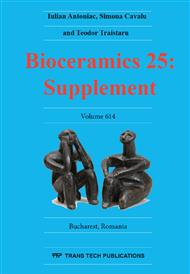p.47
p.52
p.62
p.68
p.74
p.83
p.89
p.95
p.100
Tribological Tests and SEM Analysis for Titanium Oxide Layers
Abstract:
The use of titanium and its alloys is currently considered very attractive for dental implants, with the improvement of physical properties, corrosion resistance and biocompatibility of them. These properties are attributed to the formation of titanium dioxide (TiO2) as a protective layer. The aim of this work is to understand the influence of time on heat treatment of CP-Ti Grade II at 850 oC. Heat treatments were performed for 5, 15, 30, 60 and 120 minutes. The response of titanium to oxidation at same temperatures and various timings has been investigated, in terms of wear resistance, surface morphology and oxide layer substrate adhesion. A variety of experimental and analytical techniques including scanning electron microscopy (SEM) and tribological testing have been used to characterize the resultant thermal oxidized surfaces. The results showed that oxygen diffused Ti structure can produce compact layer (TiO2), which exhibited good adhesion with the substrate at 30 minutes and 120 minutes of heat treatment.
Info:
Periodical:
Pages:
74-79
Citation:
Online since:
June 2014
Keywords:
Price:
Сopyright:
© 2014 Trans Tech Publications Ltd. All Rights Reserved
Share:
Citation:


